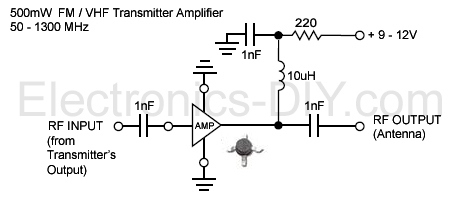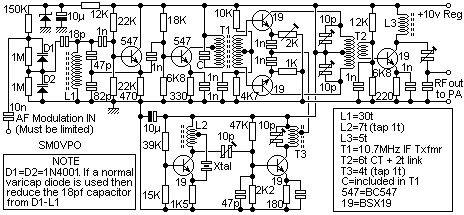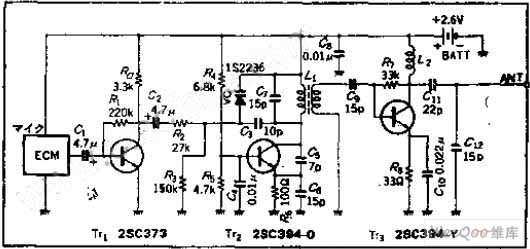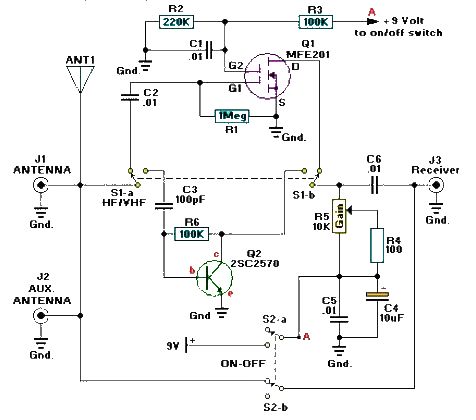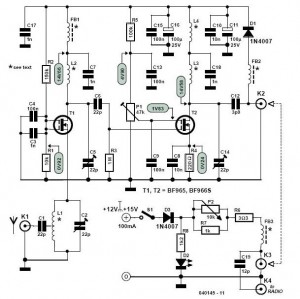
Ensemble II VHF RX rf
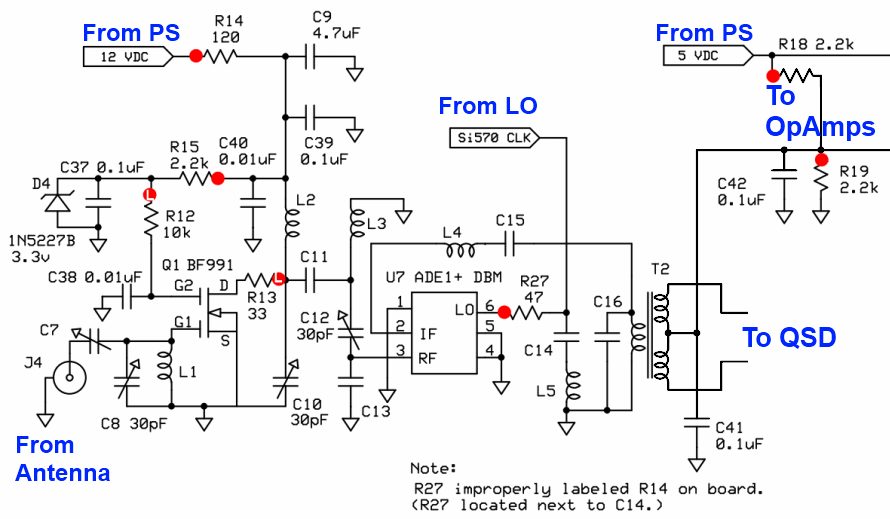
This stage begins at the VHF antenna. The incoming VHF RF signal is preamplified and filtered and presented as the "RF" signal to the ADE and Double Balanced Mixer (DBM). The mixer also accepts the Local Oscillator's output (before the Quadrature Clock Generator) as the "LO" input. The two signals, "RF" and "LO," are then mixed to result in the "IF" output of the DBM. This output contains the sum and difference products of mixing the two inputs. The sum component is filtered out, sending the difference component into the Quadrature Sampling Detector (QSD) stage. For example, assume that the VHF signal of interest is at a frequency of 145.200 MHz. Thanks to the firmware in the on-board microcontroller in the LO stage, the LO will produce an output of 116.16 MHz. The DBM accepts the preamplified and filtered incoming RF signal at 145.200 MHz along with the LO signal of 116.16 MHz to produce a signal with sum and difference components: the sum is discarded, and the difference (29.04 MHz) is sent to the QSD stage. If the SDR software was configured to set the center frequency at 145.200 MHz, then it would manifest itself in the QSD as 29.04 MHz.
The circuit begins with a VHF antenna that captures incoming radio frequency (RF) signals. The RF signal undergoes a preamplification process to boost its amplitude, followed by filtering to eliminate unwanted noise and interference. The processed RF signal is then input to a Double Balanced Mixer (DBM), where it is designated as the "RF" signal. Concurrently, the mixer receives a Local Oscillator (LO) signal, which is generated prior to the Quadrature Clock Generator by an onboard microcontroller.
The mixing of the RF and LO signals produces an Intermediate Frequency (IF) output that contains both sum and difference components. In typical operation, the sum component is filtered out, allowing only the difference component to pass through to the next stage, which is the Quadrature Sampling Detector (QSD).
As a practical example, if the VHF signal of interest is at 145.200 MHz, the LO is set to 116.16 MHz. The DBM processes these signals, resulting in a difference frequency of 29.04 MHz, which is the frequency that the QSD will analyze. If the software-defined radio (SDR) system is configured with a center frequency of 145.200 MHz, the output frequency observed at the QSD will correspond to the difference frequency of 29.04 MHz. This process is crucial in radio frequency communication systems, enabling the effective demodulation and processing of signals within the desired frequency range.This stage begins at the VHF antenna. The incoming VHF RF signal is preamplified and filtered and presented as the "RF" signal to the ADE + Double Balanced Mixer (DBM). That mixer also accepts the Local Oscillator `s output (BEFORE the Quadrature Clock Generator ) as the "LO" input.
The two signals, "RF" and "LO" are then mixed to result in the "I F" output of the DBM. This output contains the sum and difference products of mixing the two inputs. The sum component is filtered out, sending the difference component into the Quadrature Sampling Detector (QSD) stage. For example, assume that the VHF signal of interest is at a frequency of 145. 200 MHz. Thanks to the firmware in the on-board microcontroller in the LO stage, the LO will produce an output of 116.
16 MHz. The DBM accepts the preamplified and filtered incoming RF signal at 145. 200 MHz along with the LO signal of 116. 16 MHz, to produce a signal with sum and difference components: The sum ( £) is discarded and the difference ( ” = 29. 04 MHz) is sent to the QSD stage. If the SDR software was configured to set the center frequency at 145. 200 MHz, then it would manifest itself in the QSD as 29. 04 MHz. 🔗 External reference
The circuit begins with a VHF antenna that captures incoming radio frequency (RF) signals. The RF signal undergoes a preamplification process to boost its amplitude, followed by filtering to eliminate unwanted noise and interference. The processed RF signal is then input to a Double Balanced Mixer (DBM), where it is designated as the "RF" signal. Concurrently, the mixer receives a Local Oscillator (LO) signal, which is generated prior to the Quadrature Clock Generator by an onboard microcontroller.
The mixing of the RF and LO signals produces an Intermediate Frequency (IF) output that contains both sum and difference components. In typical operation, the sum component is filtered out, allowing only the difference component to pass through to the next stage, which is the Quadrature Sampling Detector (QSD).
As a practical example, if the VHF signal of interest is at 145.200 MHz, the LO is set to 116.16 MHz. The DBM processes these signals, resulting in a difference frequency of 29.04 MHz, which is the frequency that the QSD will analyze. If the software-defined radio (SDR) system is configured with a center frequency of 145.200 MHz, the output frequency observed at the QSD will correspond to the difference frequency of 29.04 MHz. This process is crucial in radio frequency communication systems, enabling the effective demodulation and processing of signals within the desired frequency range.This stage begins at the VHF antenna. The incoming VHF RF signal is preamplified and filtered and presented as the "RF" signal to the ADE + Double Balanced Mixer (DBM). That mixer also accepts the Local Oscillator `s output (BEFORE the Quadrature Clock Generator ) as the "LO" input.
The two signals, "RF" and "LO" are then mixed to result in the "I F" output of the DBM. This output contains the sum and difference products of mixing the two inputs. The sum component is filtered out, sending the difference component into the Quadrature Sampling Detector (QSD) stage. For example, assume that the VHF signal of interest is at a frequency of 145. 200 MHz. Thanks to the firmware in the on-board microcontroller in the LO stage, the LO will produce an output of 116.
16 MHz. The DBM accepts the preamplified and filtered incoming RF signal at 145. 200 MHz along with the LO signal of 116. 16 MHz, to produce a signal with sum and difference components: The sum ( £) is discarded and the difference ( ” = 29. 04 MHz) is sent to the QSD stage. If the SDR software was configured to set the center frequency at 145. 200 MHz, then it would manifest itself in the QSD as 29. 04 MHz. 🔗 External reference
Warning: include(partials/cookie-banner.php): Failed to open stream: Permission denied in /var/www/html/nextgr/view-circuit.php on line 713
Warning: include(): Failed opening 'partials/cookie-banner.php' for inclusion (include_path='.:/usr/share/php') in /var/www/html/nextgr/view-circuit.php on line 713
